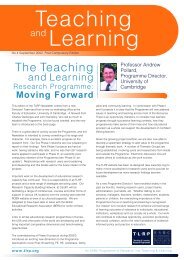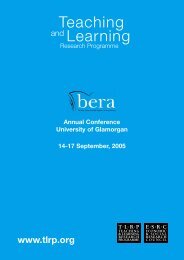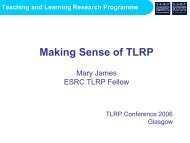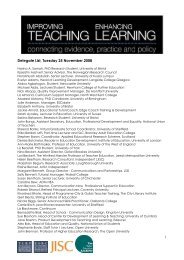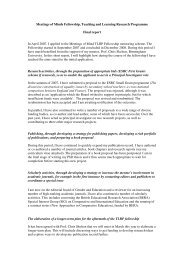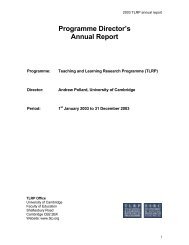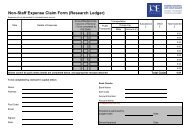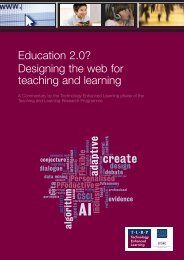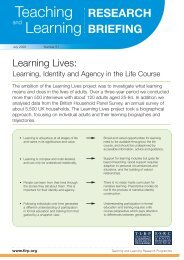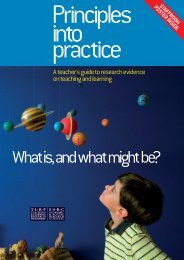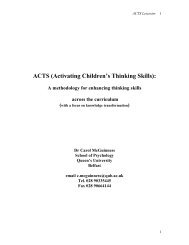Bera Booklet 2007 - Teaching and Learning Research Programme
Bera Booklet 2007 - Teaching and Learning Research Programme
Bera Booklet 2007 - Teaching and Learning Research Programme
Create successful ePaper yourself
Turn your PDF publications into a flip-book with our unique Google optimized e-Paper software.
Conference booklet 21/8/07 10:16 am Page 24Thursday6th September4.30 – 6.00pmIn this paper we address the following questions:(i) How do various students talk about their experiences of different pedagogies/T&Lcultures <strong>and</strong> themselves in relation to mathematics?(ii) How can different pedagogic mathematics cultures mediate mathematical identity,especially for those at risk of marginalisation from mathematics?In particularly, we provide comparison of data from Use of Mathematics AS (with itsemphasis on modeling, use of technology <strong>and</strong> coursework) <strong>and</strong> AS Mathematicsstudents/classrooms.The paper draws on case studies of nine AS <strong>and</strong> Use of Mathsclassrooms in five 6fFE courses, selected for diversity e.g. in socioeconomic background<strong>and</strong> mathematics GCSE entry grade requirements. It draws on analysis of repeatedinterviews with more than fifty students, teacher interviews <strong>and</strong> of videos of the numerouslessons we observed.We draw on socio-cultural theory, particularly Cultural-Historical Activity Theory, to providea view of identity as in dialectical relation to practice. This relation we refer to as identity/practice. With regard to capturing students’ mathematical identity/practice, we draw onboth interview <strong>and</strong> observational data, including artefacts of students mathematical work.We analyse these for their self-identity <strong>and</strong> their identity-in-practice (Holl<strong>and</strong> et.al.) in relationto the cultural models (Gee, 1999), especially cultural models (i.e. beliefs which informaction) about learning maths, which they use as discursive tools for self-authoring duringthe interview event or when in situ during maths classes. However, as anticipated we foundthat Use of Mathematics <strong>and</strong> Mathematics AS courses are not implemented in distinctlysimple ‘didactic’ versus ‘inquiry-based, sociable’ ways, <strong>and</strong> that the classroom culture isinfluenced by a complex of factors. For instance, in one college, we see a macro-discourseof academic performativity mediating mathematics classroom pedagogic practice <strong>and</strong>mathematics learner identity. We see this discourse at work in the talk of many students (aswell as in the talk of the teachers) <strong>and</strong> examine how this discourse mediates their mathematicalidentities. Comparison of AS Mathematics <strong>and</strong> Use of Maths classrooms, however,shows the influence of curriculum design captured in local practice <strong>and</strong> some differences inhow students negotiate their cultural models about mathematics. We present a discourseanalysis of students’ identity/practice that is contextualised within the cases concerned,<strong>and</strong> draw comparisons across studies.In another case study classroom, we see a sociable mathematics at work <strong>and</strong> we examinethe possibility that ‘sociability’ in mathematics pedagogy might afford the acquisition ofmaths as a practice (hence influencing their mathematical identities) by students whootherwise may be on the margins, which might be encouraged by engagement in commonjoint mathematical activities. Here we see connections with others, especially with the workof Boaler, Greeno, Solomon, Morais <strong>and</strong> many others.The case studies provide evidence, in artefacts of students’ work <strong>and</strong> in the ways theydescribe learning mathematics to suggest that Use of Maths AS can mediate a qualitativelydifferent classroom mathematics pedagogies <strong>and</strong> ways of identifying with learningmathematics.SYMPOSIUM PRESENTATIONNeuroscience <strong>and</strong> Education 2: Pedagogical Theory <strong>and</strong> PracticeChair: Paul Howard-Jones, University of BristolAbstract: The translation of brain-based insights into new educational approaches is notstraightforward <strong>and</strong> can be problematic. However, new insights from cognitive neuroscience,<strong>and</strong> from studies linking this knowledge to education, are now providing freshimpetus for developing <strong>and</strong> revising our ideas about pedagogy, with a new emphasis onthe need for both educational relevance <strong>and</strong> scientific validity. This symposium reports onrecent attempts by a range of researchers to link neuroscientific findings with the theory<strong>and</strong> practice of teaching <strong>and</strong> learning. Successful attempts to build bridges between thesetwo areas will depend upon an open recognition <strong>and</strong> underst<strong>and</strong>ing of the fundamentaltheir differences in terms of perspective. The first contribution in this symposium examinesthese differences directly, within the specific context of mathematics education. Followingthis, the second author identifies some of the emerging resonances between concepts fromneuroscience <strong>and</strong> popular constructivist perspectives in education. Finally, three researchedinstances of drawing upon ideas from neuroscience <strong>and</strong> applying them in educationalpractice are critically reviewed. The first involves the Raviv Method, aimed at using dailyphysical exercises to improve attention <strong>and</strong> concentration, the second involves a courseaimed at promoting resilience <strong>and</strong> well-being in managers, <strong>and</strong> the third involves supportingtrainee drama teachers in their underst<strong>and</strong>ing of how to foster creativity amongst theirpupils. Each of these three contexts required the translation of concepts from neuroscienceinto pedgagogical practice, <strong>and</strong> the authors use a variety of qualitative methods to examinethe processes involved <strong>and</strong> their consequent outcomes.Paper 1Spanning Mathematics Education <strong>Research</strong> <strong>and</strong> Cognitive Neuroscience:Conceptual, Epistemological, & Methodological DivergencesAuthors: Michael E. Martinez, University of California at Irvine <strong>and</strong> M. LayneKalbfleisch, George Mason UniversityAbstract: In the community of scholars, cross-disciplinary research efforts are generallyregarded as having high potential for new insights, even breakthroughs. Through crossdisciplinarywork, the ordinary conceptual isolation of disciplines is bridged to provide aconceptually richer, <strong>and</strong> potentially more complete, knowledge product. It is almostaxiomatic among scholars that interdisciplinary work is important, <strong>and</strong> that there should bemore of it. While that may be a widely-held belief, the institutionalization <strong>and</strong> practices ofcross-disciplinary (collaborative work between fields) or trans-disciplinary work (fields joiningto create new paradigms) are difficult in part because traditional academic success is oftenrooted in expertise defined by the academic disciplines (Koizumi, 2001).A further complication of interdisciplinary collaboration is that all forms of scholarshipare significantly social <strong>and</strong> cultural practices. Like every participant in a cultural activity,researchers adhere to norms <strong>and</strong> beliefs about what counts as knowledge in theirdiscipline; they hold assumptions about who speaks with authority <strong>and</strong> who does not.These norms can differ between disciplines. As we consider the challenge of bridging twoscholarly fields—research in mathematics education <strong>and</strong> cognitive neuroscience—we arereminded of the differing textures of social fabric within which scholarship operates.The connections between scholarship <strong>and</strong> cultural practices are clarified by distinguishingbetween domains <strong>and</strong> fields (Csikszentmihalyi & Robinson, 1986). A domain is the bodyof knowledge around which scholars organize—for chemists, it is chemistry; for historians,history. The field is broader, including not only shared knowledge, but also the values,priorities, authority structures, <strong>and</strong> norms of social interaction that scholars who study adomain accept as normal. These broader aspects of scholarship are typically taken forgranted by practitioners; they are tacit knowledge, unwritten rules of conduct <strong>and</strong> implicitbehavior assimilated by a person on the path from novice to expert (Polyani, 1976).Distinguishing between fields <strong>and</strong> domains helps clarify that the development of a scholarincludes not only mastery of a knowledge domain, but also enculturation into a field.The domain/field distinction also helps clarify why cross or trans-disciplinary study canbe unexpectedly complicated. In this essay, we consider ways in which hoped-forcollaboration between researchers from two fields is more difficult by deep-rooteddifferences in how researchers think about knowledge-building within their disciplines.Their domains of study are:• Mathematics Education <strong>Research</strong>: <strong>Learning</strong> Through Social Negotiation <strong>and</strong> Support• Cognitive Neuroscience: Mapping Brain Structure <strong>and</strong> FunctionThis discussion addresses cross-field differences in the nature of their respectiveresearch enterprises on three axes: (1) units of analysis (2) conceptual products, <strong>and</strong> (3)epistemological beliefs. We focus on how differences in these areas of study, as fields,increase the difficulty of building cross- or trans-disciplinary underst<strong>and</strong>ing <strong>and</strong> collaboration<strong>and</strong> extend to possible constructs which might bridge the gap such as number sense,place value, proportional reasoning, executive function, <strong>and</strong> automaticity.24 25



